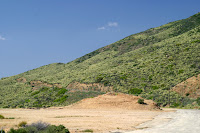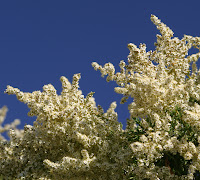 Chemise (adenostoma fasciculatum) is the most common plant in the chapparal that we live in. Today Debi and I took a drive up toward Mt. Laguna (one of the tallest peaks in San Diego County), and along the Sunrise Highway not far from Pine Valley we spotted some hills whose color was not the normal dull green (see at right; click on pictures for a larger view). Instead, there were splotches of white turning the hillside into a mottled and brighter mix of green and white. This turned out to be from all the chemise in bloom (second photo), and they were quite a sight (remember, this is a desert!). I'm sure the spectacular and unusually synchronous bloom is due to the heavy rains this year, though I don't know the actual mechanism.
Chemise (adenostoma fasciculatum) is the most common plant in the chapparal that we live in. Today Debi and I took a drive up toward Mt. Laguna (one of the tallest peaks in San Diego County), and along the Sunrise Highway not far from Pine Valley we spotted some hills whose color was not the normal dull green (see at right; click on pictures for a larger view). Instead, there were splotches of white turning the hillside into a mottled and brighter mix of green and white. This turned out to be from all the chemise in bloom (second photo), and they were quite a sight (remember, this is a desert!). I'm sure the spectacular and unusually synchronous bloom is due to the heavy rains this year, though I don't know the actual mechanism.
At this point, the highway is about 4,500 feet above sea level, so the bloom here is a few weeks behind the chemise bloom at our home. The bloom there wasn't nearly as overwhelming as these hillsides. Plus we don't normally think of chemise as "attractive"...but that's a different story...
 Anyone who knows us well is probably very surprised to see the word "chemise" without cuss words nearby in anything I've written. That's because most of the time, chemise is (a) ugly, (b) wretched looking, (c) out-competing much more desirable plants, (d) a serious fire hazard (dry, oily, easily ignited wood), and (e) ugly. Chemise is my enemy. I spend lots of time, effort, and money attempting to eradicate chemise from my property.
Anyone who knows us well is probably very surprised to see the word "chemise" without cuss words nearby in anything I've written. That's because most of the time, chemise is (a) ugly, (b) wretched looking, (c) out-competing much more desirable plants, (d) a serious fire hazard (dry, oily, easily ignited wood), and (e) ugly. Chemise is my enemy. I spend lots of time, effort, and money attempting to eradicate chemise from my property.
But just today, I'll grant that it can be, under certain very limited circumstances that include it being off my property, attractive.








